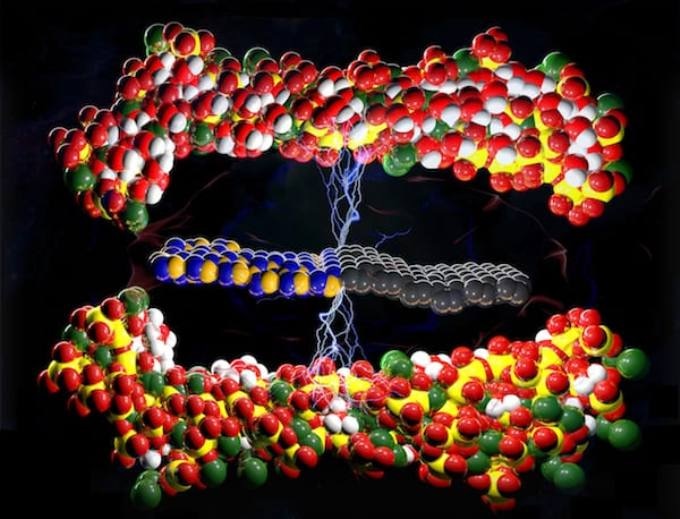Feb 6 2019
A ceramic that turns less electrically conductive when subjected to plastic strain and more conductive under elastic strain could open the door for a new generation of sensors that can be integrated into structures such as bridges, buildings, and aircraft with the ability to monitor their own health.
 Ceramics with networked nanosheets of graphene and white graphene would have the unique ability to alter their electrical properties when strained, according to a researcher at Rice University. The surprising ability could lead to new types of structural sensors. (Image credit: Rouzbeh Shahsavari)
Ceramics with networked nanosheets of graphene and white graphene would have the unique ability to alter their electrical properties when strained, according to a researcher at Rice University. The surprising ability could lead to new types of structural sensors. (Image credit: Rouzbeh Shahsavari)
The electrical disparity advanced by the two forms of strain was not evident until Rouzbeh Shahsavari, an assistant professor of civil and environmental engineering and of materials science and nanoengineering at Rice University, and his team modeled graphene-boron-nitride (GBN), an innovative two-dimensional compound.
Upon being subjected to elastic strain, there is no change in the internal structure of a material that is stretched like a rubber band. However, under plastic strain—caused here by stretching it sufficiently far beyond elasticity to deform—the crystalline lattice of the same material gets distorted. It has been observed that GBN exhibits different electrical properties in every case, making it a useful material as a structural sensor.
Even earlier, Shahsavari had found out that hexagonal-boron nitride, also called white graphene, had the ability to enhance the properties of ceramics. Currently, he and his team have found out that they can be made more versatile and even stronger by adding graphene, with an improvement in their fascinating electrical properties.
The charm lies in the potential of two-dimensional, carbon-based graphene and white graphene to gel with each other in a range of ways, based on their relative concentrations. Despite the fact that white graphene and graphene avoid water by nature, making them clump, the combined nanosheets effortlessly disperse in a slurry when the ceramic is manufactured.
According to the theoretical models of the authors, the ensuing ceramics would turn into tunable semiconductors with improved strength, elasticity, and ductility.
The study headed by Shahsavari and Asghar Habibnejad Korayem, an assistant professor of structural engineering at Iran University of Science and Technology and a research fellow at Monash University in Melbourne, Australia, has been published in the American Chemical Society journal Applied Materials and Interfaces.
Graphene is a well-researched form of carbon famous for its lack of a band gap—the region that has to be overcome by an electron to make a material conductive. Since there is no band gap, graphene behaves as a metallic conductor. White graphene has a wide band gap, and hence is an insulator. Therefore, the ratio of graphene in the 2D compound is directly proportional to the conductivity of the material.
Upon being mixed into the ceramic at a sufficiently higher concentration, the 2D compound named GBN would form a network that is as conductive as the carbon quantity in the matrix enables. This provides the overall composite with a tunable band gap that can lend itself to a range of electrical applications.
Fusing 2D materials like graphene and boron nitride in ceramics and cements enables new compositions and properties we can’t achieve with either graphene or boron nitride by themselves.
Rouzbeh Shahsavari, Assistant Professor, Rice University.
The researchers modeled the variations of the 2D compound combined with tobermorite by using density functional theory calculations, where tobermorite is a calcium silicate hydrate material usually used as cement for concrete. They established that the oxygen-boron bonds formed in the ceramic would become a p-type semiconductor.
Although the band gap of tobermorite is itself large—about 4.5 eV—the researchers calculated that upon being mixed with GBN nanosheets of equal parts white graphene and graphene, that gap would contract to 0.624 eV.
Upon being strained under the elastic regime, there was a drop in the band gap of the ceramic, making the material more conductive; however, when the material was stretched beyond elasticity—i.e., in the plastic regime—it turned less conductive. According to the researchers, such a change renders it to be a potential material for self-sensing and structural health monitoring applications.
The researchers proposed that other 2D sheets made of niobium diselenide, molybdenum disulfide, or layered double hydroxides may offer analogous opportunities for the bottom-up design of multifunctional, tunable composites.
This would provide a fundamental platform for cement and concrete reinforcement at their smallest possible dimension.
Rouzbeh Shahsavari, Assistant Professor, Rice University.
Graduate students Ehsan Hosseini and Mohammad Zakertabrizi of the Iran University of Science and Technology are the co-authors of the paper. The study was supported by the National Science Foundation and the Australian Research Council.